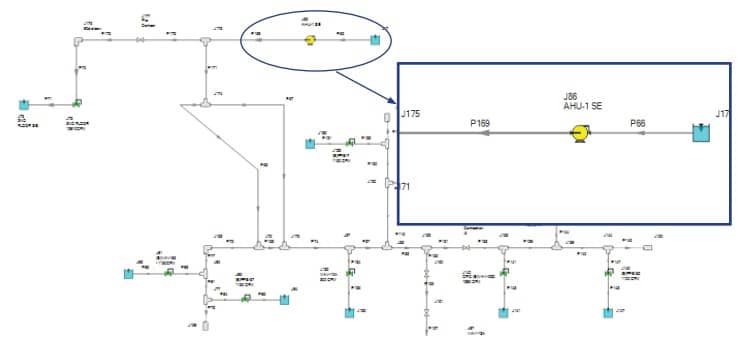AFT Fathom Instrumental in Reconfiguring Office Building HVAC System
AFT Fathom™ Case Study
Swanson Rink | HVAC System | Commercial Building

“The [AFT Fathom] model was invaluable in being able to
demonstrate that our designed system would perform within
the existing fan parameters.”
– Rory Heim, Mechanical Engineer
PROBLEM
- Office remodel increased occupancy, in turn increasing cooling demand
- Unable to increase fan speed to compensate as the existing operation was close to maximum flow
ANALYSIS
- AFT Fathom was used to model low-pressure air
- Required flowrate informed by thermal-load software indicated current equipment was insufficient
SOLUTION
- Change in operating temperature avoided new equipment
- Comparison of initial model to field data provided confidence in post-construction expectations
Ready to try AFT Fathom?
Problem Explained
Swanson Rink was tasked with increasing the airflow for the second floor of a two-story office building as part of a remodeling project.
The remodel would increase the office building’s occupancy, leading to a rise in cooling demands. The east side of the building is served by an air handling unit (AHU-1), and the west side of the building is served by a second air handling unit (AHU-2).
Increased cooling is typically provided by raising fan speed. However, the AHUs serving this space were already operating close to their maximum airflow rate and did not have the capacity to increase the fan speed significantly.
Product performance data for the AHUs and fans was unavailable, so there were no fan curves to determine if the fans could accommodate the increased airflow.
Tools & Analysis
Rory Heim, mechanical engineer at Swanson Rink, used AFT Fathom in conjunction with a thermal loads program to analyze the fan performance required by different load configurations.
The thermal loads program used the standard 55 F (13 C) supply air temperature to condition the space and calculated the required cubic feet per minute (CFM). Heim then modeled the system in AFT Fathom using the calculated airflow rate values to determine the new desired operating points for each AHU fan.
When the static pressure and airflow rates of each AHU were measured, Heim determined the real static pressures were too low compared to the AFT Fathom model’s desired pressures at the same flowrate.
“AFT Fathom allowed us to accurately determine the minimum system conditions we needed for a functional design,” said Heim. “When those minimum system conditions—CFM/static pressure—couldn’t be met by existing equipment, AFT Fathom allowed us to rapidly evaluate different strategies to satisfy the restricting design parameter—fan performance.”
Solutions & Benefits
Heim said that receiving measured field data from existing equipment that closely matched their model data gave the team confidence in the model. It allowed the team to move forward with the assurance that post-construction data would closely match AFT Fathom predicted data.
The project has since been completed and the system balanced to Swanson Rink’s design values. The AFT Fathom model was in close agreement with the installed operating points. The final operating points were 20,849 CFM (590 m3/min) and 1.03 in. water (26 mm water) for AHU-1 and 25,297 CFM (716 m3/min) and 1.12 in water (28 mm water) for AHU-2.
“If you calculate a percentage error based on our design and the installed operating points, the model may seem inaccurate, but in this case, the model was invaluable in being able to demonstrate that our designed system would perform within the existing fan parameters,” said Heim. “To be within 0.09” (AHU-1) and 0.12” (AHU-2) of static between our desired operating points at 50 F and the BAS (building automation system’s) measured operating points, speaks to the accuracy of our model and the abilities of AFT Fathom to accurately model complicated ducting systems.”

